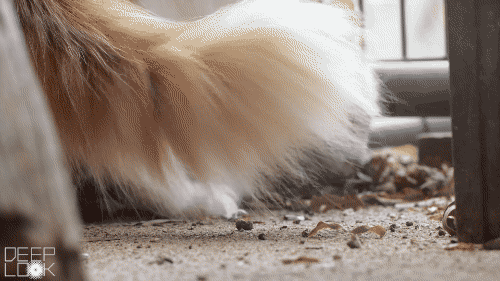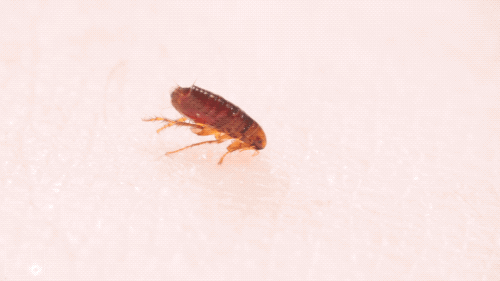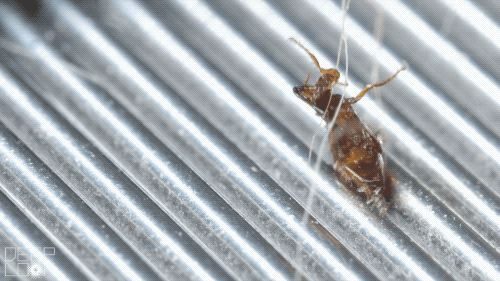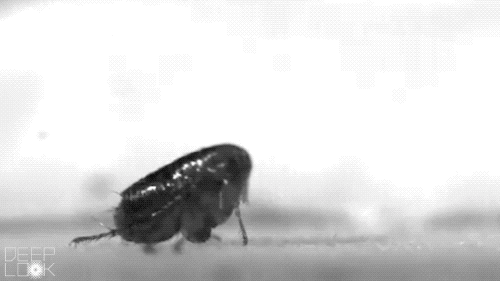A Flea's Fantastic Jump Takes More Than Muscle
Spring is here, and with it, the start of flea season. With the warming weather, people and their pets are spending more time outside — which increases the chances of bringing home a hungry “itch hiker.”
While pet owners curse the tiny insects and look for a way to rid them from their homes, it turns out fleas actually perform some remarkable athletic feats, like jumping 50 times their height — the equivalent of a human jumping 300 feet — or leaping so fast that they take off 100 times faster than the blink of an eye.
No larger than a sesame seed and flattened side to side, fleas can slip through fur with ease. But what makes them really elusive is their jump. It’s so fast they seem to simply vanish and reappear somewhere else.
“It’s there and then it’s gone,” said Gregory Sutton, a professor of biomechanics at the University of Lincoln in the United Kingdom.

Sutton uses high-speed cameras and magnifying lenses to research how fleas are able to do their age-old disappearing tricks.
In one recent study, Sutton found that the way different animals jump is apparently not one size fits all.
Fleas are ridiculously fast jumpers. Sutton found that a flea could complete its takeoff in as little as one millisecond.
Adult fleas use that fast jump to get away from danger, but also to leap onto their furry or feathered hosts. Once they’re aboard, fleas use their sharp tube-shaped proboscis, called a stylet, to pierce the skin and suck the host’s blood.

Once both males and female fleas feed, they mate and the females lay eggs. Unlike with other pests like lice, flea eggs don’t stick to fur. Instead, they fall from the host’s fur, typically into its bedding.
But eggs aren’t the only things adult fleas create. They’re also prodigious poopers.
The eggs and flea poop combination are found deep in the pet’s fur, or on its bedding. It’s easy to find with a flea comb.

“People call it salt and pepper,” said William Donahue, an entomologist, and owner of Sierra Research Laboratories in Modesto, where he evaluates treatments against fleas and other pests. “It will be the dark black fecal spots, plus the white pearlescent eggs.”
The eggs and poop fall out of the host’s fur when it moves. It’s especially common to find them in the pet’s bedding.

“They’re not on the surface of hardwood floors or tiles or anything like that,” Sutton said. “They fall into the pet’s bedding, and there’s usually a microclimate in there with higher humidity, which is conducive to them surviving.”
After a few days, the eggs hatch and the nearly microscopic larvae wiggle out. They look like hairy white worms the size of a piece of dust. The larvae spend weeks crawling around the bedding, or nest in the case of many birds.
The larvae feed on whatever organic matter they can find. But their favorite food comes from their parents. Adult flea poop is just semi-digested blood and it tends to fall in the same places as the eggs.

After a lot of gorging and growing, the wiggling larva encases itself in a cocoon. A couple of days later, the adult flea emerges.
The first thing it needs to do is find a host to hitch a ride on. That’s where the flea’s spectacular jump comes in.
Fleas can jump over fifty times their own height. They need to accelerate very quickly to launch themselves.
“But they’ve got short little legs,” Sutton said. “So the fleas don’t have a lot of time to accelerate before they leave the ground.”
You might think fleas have special muscles in their legs that allow them to jump extra fast. Not so.
“When you look at the muscles in these guys,” Sutton said, “it just looks like normal muscles, and muscles can only move so quickly. So they need something to amplify the power output.”
What they have is a spring. But it’s not like the coiled metal spring that might first come to mind.
“When I say spring, I mean something that is storing and releasing mechanical energy in a recoil,” Sutton said.

Adult fleas use their muscles to store energy by bending a part of their exoskeleton called the pleural arch.
“Basically, it’s their metaphorical rib cage,” Sutton said. “It’s the part of the flea’s body that would be closest to the human rib cage.”
When the flea releases the bending, its exoskeleton snaps back into its original shape extremely quickly. The energy from that recoil gets transmitted through the flea’s tiny body into its oversized rear legs which push off the ground, sending the flea soaring into the air. Larger animals like dogs and cats have longer legs, and they power their jumps with muscles alone.
Sutton likened the flea’s jump to firing a bow. An archer uses the muscles in his or her arm to load energy into a bow, which is released very suddenly, and transferred into the lightweight arrow very quickly.
But for something heavier like a spear, humans wouldn’t use a bow, and instead would use muscles in their arm and shoulder to heave the heavier object directly.
The two different systems seem to meet in animals around the size of a frog, with some smaller, quicker-jumping frogs using the spring system like the flea, and larger frogs, like bullfrogs, using muscles like a cat or dog.
Sutton studies animal jumps in the hope that his findings will help the development of jumping robots.
“One of the things that the insects do better now than robots is generating jumps,” he said. “The jumps of small insects are much faster and more controlled than the jumps of equivalently sized robots. And insects can jump in preparation for flight. That’s incredibly useful as well, that we’re trying to figure out how to get robots to do that.”
But just to keep the record straight, while they are among the fastest animal jumpers, fleas did not top Sutton’s list. Froghoppers, also called spittlebugs, took the top spot.
“Froghoppers are the fastest of the insect jumpers, but they live on plants and they’re actually spectacularly terrified of us so we don’t see them very often and don’t notice them,” said Sutton.
“We usually don’t think about things in nature moving that quickly. So that’s why I love them, said Sutton. “They just go fast.”
